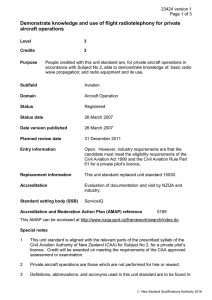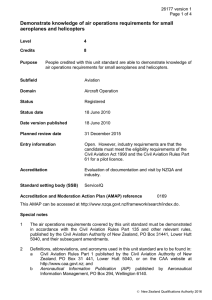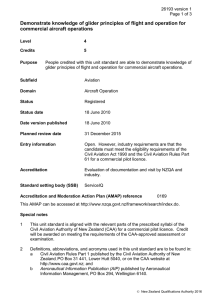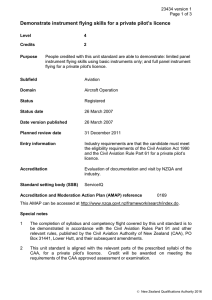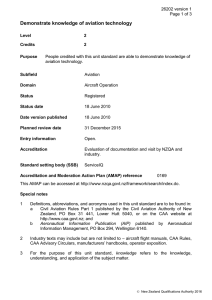Demonstrate competence for a Category B flight instructor rating
advertisement
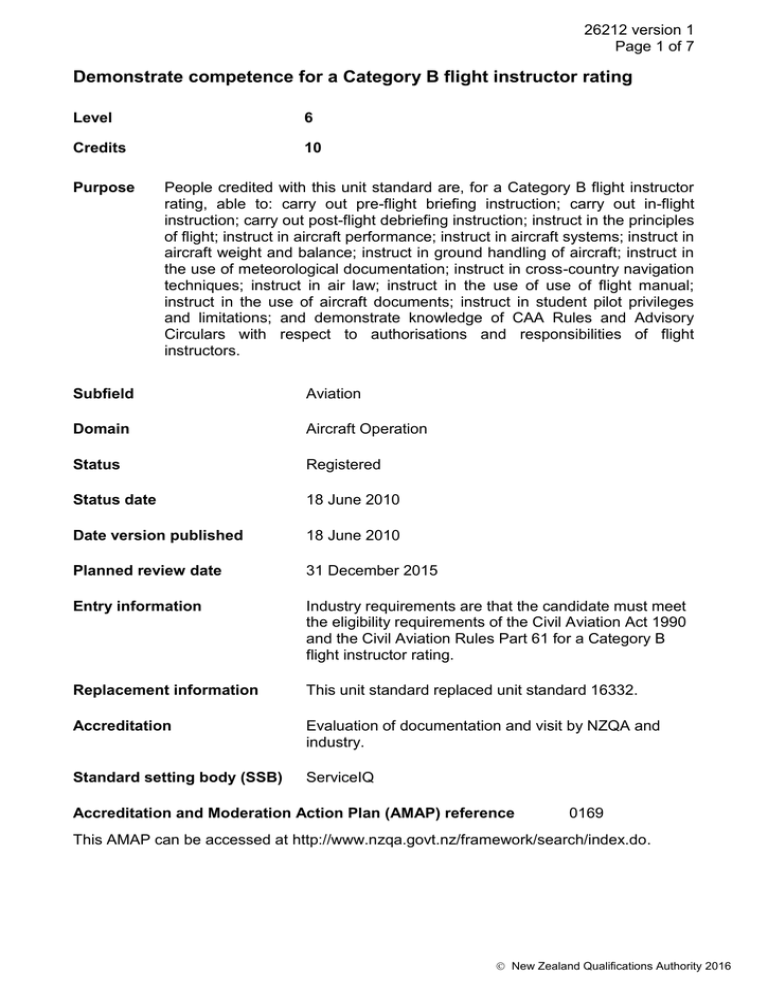
26212 version 1 Page 1 of 7 Demonstrate competence for a Category B flight instructor rating Level 6 Credits 10 Purpose People credited with this unit standard are, for a Category B flight instructor rating, able to: carry out pre-flight briefing instruction; carry out in-flight instruction; carry out post-flight debriefing instruction; instruct in the principles of flight; instruct in aircraft performance; instruct in aircraft systems; instruct in aircraft weight and balance; instruct in ground handling of aircraft; instruct in the use of meteorological documentation; instruct in cross-country navigation techniques; instruct in air law; instruct in the use of use of flight manual; instruct in the use of aircraft documents; instruct in student pilot privileges and limitations; and demonstrate knowledge of CAA Rules and Advisory Circulars with respect to authorisations and responsibilities of flight instructors. Subfield Aviation Domain Aircraft Operation Status Registered Status date 18 June 2010 Date version published 18 June 2010 Planned review date 31 December 2015 Entry information Industry requirements are that the candidate must meet the eligibility requirements of the Civil Aviation Act 1990 and the Civil Aviation Rules Part 61 for a Category B flight instructor rating. Replacement information This unit standard replaced unit standard 16332. Accreditation Evaluation of documentation and visit by NZQA and industry. Standard setting body (SSB) ServiceIQ Accreditation and Moderation Action Plan (AMAP) reference 0169 This AMAP can be accessed at http://www.nzqa.govt.nz/framework/search/index.do. New Zealand Qualifications Authority 2016 26212 version 1 Page 2 of 7 Special notes 1 The flight covered by this unit standard must be demonstrated in accordance with the Civil Aviation Rules Part 91 and other relevant rules, published by the Civil Aviation Authority of New Zealand (CAA), PO Box 31441, Lower Hutt 5040, and their subsequent amendments. 2 This unit standard is aligned with the relevant parts of the prescribed syllabi of the CAA for a Category B flight instructor rating. Credit will be awarded on meeting the requirements of the CAA-approved assessment or examination. 3 Definitions, abbreviations, and acronyms used in this unit standard are to be found in: a Civil Aviation Rules Part 1 published by the Civil Aviation Authority of New Zealand, PO Box 31 441, Lower Hutt 5040, or on the CAA website at http://www.caa.govt.nz; and b Aeronautical Information Publication (AIP) published by Aeronautical Information Management, PO Box 294, Wellington 6140. 4 All references to the CAA refer specifically to the Civil Aviation Authority of New Zealand. 5 Industry standards and recommended practices are those set in place by the CAA. 6 Industry texts may include but are not limited to – aircraft flight manuals, Civil Aviation Act 1990, CAA Rules, CAA Advisory Circulars, CAA Flight Test Standards Guides, operator exposition. Elements and performance criteria Element 1 Carry out pre-flight briefing instruction. Performance criteria 1.1 Pre-flight briefing instruction is carried out in accordance with industry texts and standards. Range 1.2 pre-brief, purpose and techniques, critical reflection, environmental considerations, effectiveness. Ground instructional technique and procedures are demonstrated in accordance with industry texts and standards. Range formal ground briefing, purpose and techniques, critical reflection, environmental considerations, effectiveness. New Zealand Qualifications Authority 2016 26212 version 1 Page 3 of 7 Element 2 Carry out in-flight instruction. Performance criteria 2.1 In-flight instructional technique and procedures are demonstrated in accordance with industry texts and standards. Range includes but is not limited to – normal and emergency procedures, basic and advanced manoeuvres, airmanship, situational awareness, lookout, role modelling, in-flight patter, hand over and follow through, student has adequate time to practice the manoeuvre without being overridden, periodic check of trim, fault analysis and correction. Element 3 Carry out post-flight debriefing instruction. Performance criteria 3.1 Post-flight debriefing instruction is carried out in accordance with industry texts and standards. Range includes but is not limited to – fault analysis and correction, corrective actions, constructive feedback. Element 4 Instruct in the principles of flight. Performance criteria 4.1 Instruction in the principles of mechanics is demonstrated in accordance with industry texts and standards. 4.2 Instruction in the principles of air and airflow is demonstrated in accordance with industry texts and standards. 4.3 Instruction in the principles of lift is demonstrated in accordance with industry texts and standards. 4.4 Instruction in the principles of drag is demonstrated in accordance with industry texts and standards. 4.5 Instruction in the principles of aerofoils is demonstrated in accordance with industry texts and standards. 4.6 Instruction in the principles of propellers is demonstrated in accordance with industry texts and standards New Zealand Qualifications Authority 2016 26212 version 1 Page 4 of 7 4.7 Instruction in the principles of level flight is demonstrated in accordance with industry texts and standards. 4.8 Instruction in the principles of gliding is demonstrated in accordance with industry texts and standards 4.9 Instruction in the principles of climbing is demonstrated in accordance with industry texts and standards. 4.10 Instruction in the principles of turning is demonstrated in accordance with industry texts and standards. 4.11 Instruction in the principles of stability and control is demonstrated in accordance with industry texts and standards. Element 5 Instruct in aircraft performance. Performance criteria 5.1 Instruction in aerodrome geometry and take-off flight path is demonstrated taught in accordance with industry texts and standards. 5.2 Instruction in take-off speeds and their effects on aircraft is demonstrated in accordance with industry texts and standards. 5.3 Instruction in the factors affecting take-off and landing distances, their calculation, and use is demonstrated in accordance with industry texts and standards. 5.4 Instruction in the factors affecting aircraft load factor is demonstrated in accordance with industry texts and standards. Element 6 Instruct in aircraft systems. Performance criteria 6.1 Instruction in airframes is demonstrated in accordance with industry texts and standards. 6.2 Instruction in associated systems is demonstrated in accordance with industry texts and standards. New Zealand Qualifications Authority 2016 26212 version 1 Page 5 of 7 Element 7 Instruct in aircraft weight and balance. Performance criteria 7.1 Instruction in the effects of aircraft weight and balance is demonstrated in accordance with industry texts and standards. Element 8 Instruct in ground handling of aircraft. Performance criteria 8.1 Instruction in the ground handling of aircraft is demonstrated in accordance with industry texts and standards. Element 9 Instruct in the use of meteorological documentation. Performance criteria 9.1 Instruction in meteorological information, its interpretation, and its use in aviation is demonstrated in accordance with industry texts and standards. 9.2 Instruction in weather maps and their use in aviation is demonstrated in accordance with industry texts and standards. Element 10 Instruct in cross-country navigation techniques. Performance criteria 10.1 Instruction in cross-country navigation techniques is demonstrated in accordance with industry texts and standards. Element 11 Instruct in air law. Performance criteria 11.1 Instruction in air law is demonstrated in accordance with industry texts and standards. New Zealand Qualifications Authority 2016 26212 version 1 Page 6 of 7 Element 12 Instruct in the use of aircraft flight manual. Performance criteria 12.1 Instruction in the use of aircraft flight manuals is demonstrated in accordance with industry texts and standards. Element 13 Instruct in the use of aircraft documents Performance criteria 13.1 Instruction in the use of aircraft documents is demonstrated in accordance with industry texts and standards. Element 14 Instruct in student pilot privileges and limitations. Performance criteria 14.1 Instruction in student pilot privileges is demonstrated in accordance with CAA Rules and Advisory Circulars. 14.2 Instruction in student pilot limitations is demonstrated in accordance with CAA Rules and Advisory Circulars. Element 15 Demonstrate knowledge of CAA Rules and Advisory Circulars with respect to authorisations and responsibilities of flight instructors. Performance criteria 15.1 Private pilot licences, commercial pilot licences, and Category C and B flight instructor ratings are explained in accordance with CAA rules and Advisory Circulars. Range flight instruction, direct and indirect instruction supervision, first solo, night instruction, aerobatics instruction, spinning instruction, multi-engine instruction, instrument flight rating instruction, crosscountry instruction, authorising solo flight, logbook certification, type ratings, PPL and CPL cross-country limitations, BFR RPL, BFR PPL, BFR CPL, supervising C Cat instructors, instructor renewal requirements New Zealand Qualifications Authority 2016 26212 version 1 Page 7 of 7 Please note Providers must be accredited by NZQA, or an inter-institutional body with delegated authority for quality assurance, before they can report credits from assessment against unit standards or deliver courses of study leading to that assessment. Industry Training Organisations must be accredited by NZQA before they can register credits from assessment against unit standards. Accredited providers and Industry Training Organisations assessing against unit standards must engage with the moderation system that applies to those standards. Accreditation requirements and an outline of the moderation system that applies to this standard are outlined in the Accreditation and Moderation Action Plan (AMAP). The AMAP also includes useful information about special requirements for organisations wishing to develop education and training programmes, such as minimum qualifications for tutors and assessors, and special resource requirements. Comments on this unit standard Please contact the ServiceIQ qualifications@serviceiq.org.nz if you wish to suggest changes to the content of this unit standard. New Zealand Qualifications Authority 2016
